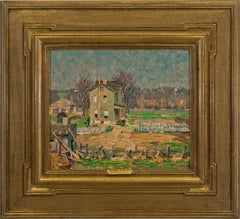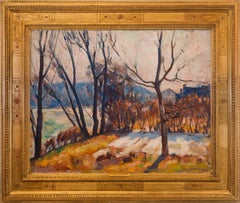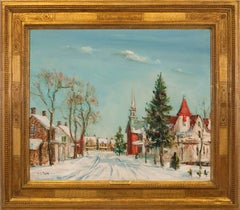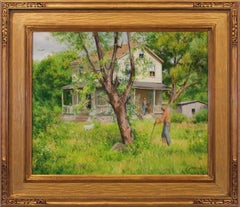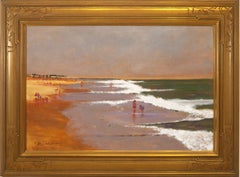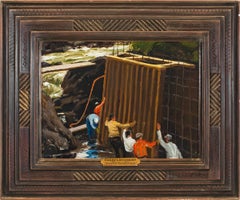Jim's of Lambertville Art
to
26
52
58
36
21
Overall Width
to
Overall Height
to
1
184
8
7
13
20
24
10
1
193
100
71
2
148
38
7
58
31
23
19
13
13
13
8
8
6
6
6
5
5
4
4
4
4
3
3
182
179
130
130
41
50
18
13
12
9
189
193
Style: Impressionist
"Pat's House"
By Robert Spencer
Located in Lambertville, NJ
Jim’s of Lambertville is proud to offer this artwork by:
Robert Spencer (1879 - 1931)
One of the rarest and most important artists among the New Hope School, Robert Spencer was bor...
Category
20th Century Impressionist Landscape Paintings
Materials
Canvas, Oil
"Trees Along the River"
By John Fulton Folinsbee
Located in Lambertville, NJ
Jim’s of Lambertville Fine Art Gallery is proud to present this piece by John Fulton Folinsbee (1892 - 1972).
One of the finest painters to embark upon the New Hope Art Colony, John...
Category
1930s American Impressionist Landscape Paintings
Materials
Canvas, Oil
"Snow Covered Village"
By Walter Emerson Baum
Located in Lambertville, NJ
Jim’s of Lambertville is proud to offer this artwork.
Signed lower left. Complemented by a hand carved and gilt frame.
Walter Emerson Baum (1884 - 1956)
Born in Sellersville, Pe...
Category
1930s American Impressionist Landscape Paintings
Materials
Canvas, Oil
"Yard Work, Stockton, NJ"
By Alexander Farnham
Located in Lambertville, NJ
Jim’s of Lambertville is proud to offer this artwork.
Signed lower right. Complemented by a hand carved and gilt frame.
Alexander Farnham (b.1926)
Alexander Farnham studied with Anne Steele Marsh, Van Deering Perrine, and at the Art Students League with George Bridgman...
Category
1950s American Impressionist Landscape Paintings
Materials
Canvas, Oil
"Passing Storm, Long Beach Island, New Jersey"
By Anthony Michael Autorino
Located in Lambertville, NJ
Jim’s of Lambertville is proud to offer this artwork.
Signed lower left. Complemented by a hand carved and gilt frame.
Anthony Michael Autorino (1937 - 2015)
The son of Italian immigrants, Anthony Michael Autorino was born on September 29, 1937 in Montclair, New Jersey. As a teenager, Autorino enlisted in the United States Air Force where he served an eight-year tour. His expertise in the field of cryptography landed him in Paris in the mid-1950s as an Air Force sergeant working at the United States Embassy.
While in Paris, Anthony became quite involved in the art community which reinforced his desire to make painting his career focus. Upon returning to the United States in 1961, Autorino divided time painting between upstate New York and New England. By the mid-1960s, New York City had become the center of activity for the career of this highly regarded young artist.
By 1968, disillusioned by the hustle and bustle, Autorino made the decision to relocate. His passion for paintings nature and the outdoors led him to the Delaware Valley. Charmed by the welcoming art...
Category
20th Century American Impressionist Landscape Paintings
Materials
Oil
"Concrete Construction"
By Harry Leith-Ross
Located in Lambertville, NJ
Jim’s of Lambertville is proud to offer this artwork.
Signed lower left.
Illustrated in "New Hope for American Art"
Harry Leith-Ross (1886 - 1973)
The son of an English father and a Dutch mother, Harry Leith-Ross was born in the British Colony of Mauritius, an island in the Indian Ocean a thousand miles off the southeast coast of Africa. His first formal art instruction began in England under Stanhope Forbes, followed by studies with Jean Paul Laurens at the Academie Julian in Paris. Leith-Ross came to the United States to enroll at the National Academy of Design in New York City in 1910, and then to Woodstock, in 1913. It was in Woodstock at the Art Students League, under the tutelage of Birge Harrison and John F. Carlson, that Leith-Ross would receive the training that most influenced his career as an artist.
There he formed a lifelong friendship with fellow artist, John Folinsbee. The two artists shared a studio during this time and participated in several joint exhibitions exclusively featuring their work, including an exhibit at the Louis Katz...
Category
20th Century American Impressionist Landscape Paintings
Materials
Oil, Board
"Family Reunion"
By Paulette Victorine J. Van Roekens
Located in Lambertville, NJ
Jim’s of Lambertville is proud to offer this artwork by:
Paulette Van Roekens (1896 - 1988)
Initially trained as a sculptor, Paulette Van Roekens decided to focus on painting after...
Category
21st Century and Contemporary American Impressionist Figurative Paintings
Materials
Canvas, Oil
"Old Schooner"
By Henry Bayley Snell
Located in Lambertville, NJ
Jim’s of Lambertville is proud to offer this artwork.
Oil on canvas. Signed lower right. Complemented by a hand carved and gilt frame.
Illustrated in "New Hope for American Art" by James Alterman.
Henry Bayley Snell (1858 - 1943)
Henry Bayley Snell was born in Richmond, England, on September 29, 1858 and immigrated to the United States at the age of seventeen. He studied at the Art Students League in New York while working for an etching and engraving company where he began a lifelong friendship with fellow artists, William Langson Lathrop. While in New York Snell met another artist, named Florence Francis, also of English descent, whom he would eventually marry in 1888. It is believed that they first came to Bucks County in 1898 to visit the Lathrops at Phillips Mill.
Snell was a beloved teacher at the Philadelphia School of Design for Women from 1899 to 1943, and often took his art classes abroad during the summer. He would frequently visit his native England, spending time at the art colony of St. Ives on the coast of Cornwall. Snell would summer in Gloucester, Massachusetts, and Boothbay Harbor, Maine, where he also held painting classes. Almost all the women who exhibited with “The Philadelphia Ten” had studied with Snell either in Philadelphia or New England. Snell also taught on Saturdays at the Grand Central Galleries in New York City.
The Snells made many trips to New Hope before settling there permanently in 1925. They lived on the top floor of the Solebury National Bank Building where Henry also maintained a studio. This was located at the foot of the New Hope-Lambertville Bridge and many of Snell’s New Hope scenes were painted from this location. In 1943, Snell passed away in New Hope at the age of eighty-four.
Henry Snell earned an international reputation as an artist for his paintings of Cornwall...
Category
1920s American Impressionist Landscape Paintings
Materials
Canvas, Oil
"Frances in Braids"
By Daniel Garber
Located in Lambertville, NJ
Jim’s of Lambertville is proud to offer this artwork.
Pastel portrait of artist's granddaughter.
Complemented by original signed Harer frame.
Illustra...
Category
1930s American Impressionist Portrait Paintings
Materials
Pastel
"57th Street Window"
By Mary Elizabeth Price
Located in Lambertville, NJ
Jim’s of Lambertville is proud to offer this artwork.
Signed lower left. Complemented by a hand carved and gilt frame.
M. Elizabeth Price (1877 - 1965)
Mary Elizabeth Price was born in West Virginia and raised on a farm in Solebury, Pennsylvania, on the outskirts of New Hope. She studied at the Pennsylvania School of Industrial Arts and the Pennsylvania Academy of the Fine Arts under Hugh Breckenridge. Additionally, she studied in New Hope with William Lathrop. Following her art studies, Price went to New York. While there, she conducted the “Baby Art...
Category
1920s American Impressionist Still-life Paintings
Materials
Canvas, Oil
"The Neighbors"
By George William Sotter
Located in Lambertville, NJ
Jim’s of Lambertville is proud to offer this artwork.
Signed lower right and is Illustrated in the Ashley John Gallery catalog titled "The Pennsylvania Impressionists".
George William Sotter (1879 - 1953)
Born in Pittsburgh on September 25, 1879, Sotter began his art education with local teachers and with Henry G. Keller, who had studied in various German academies. Keller, known for his superb, atmospheric watercolors, taught at the Cleveland School of Art but Sotter studied with him in Pittsburgh. Later Sotter would exhibit between 1903 and 1937 at the Pennsylvania Academy of the Fine Arts. His works were also shown at the Corcoran Gallery (1912-23), the Carnegie International (1901-26), the National Academy of Design (1913 and 1921), and at the Art Institute of Chicago (1911-27). In 1915, Sotter exhibited four works at the Panama-Pacific International Exposition in San Francisco, where he won a silver medal. Sotter was known mainly as a stained-glass artist; his work may be seen from New York City to Salt Lake City. Around a dozen craftsmen worked under him for these commissions.
Sotter spent the summer of 1902 with Pennsylvania impressionist Edward Redfield in Boothbay Harbor, Maine. Between 1910 and 1919, Sotter taught at the Carnegie Institute of Technology. His paintings often feature large areas of sky filled with clouds and he frequently painted winter night scenes, such as Moonlight, Bucks County (Beacon Hill Fine Art), a perfectly successful depiction of a quiet, moonlit landscape filled with twinkling stars. Star-studded skies, although rare in landscape painting, go back at least to 1600 when they appear in the oeuvre of Adam Elsheimer...
Category
20th Century American Impressionist Paintings
Materials
Canvas, Oil
"Note of the City"
By Robert Spencer
Located in Lambertville, NJ
Jim’s of Lambertville is proud to offer this artwork.
Signed lower right
Period frame
Robert Spencer (1879 - 1931)
One of the rarest and most important artists among the New Hope...
Category
20th Century American Impressionist Paintings
Materials
Canvas, Oil
"The Canal"
By Edward Willis Redfield
Located in Lambertville, NJ
Jim’s of Lambertville is proud to offer this artwork.
Signed lower left. Complemented by a hand carved and gilt frame.
Illustrated in "Edward Redfield: Just Values and Fine Seeing" by Constance Kimmerle and the Pennsylvania Academy of the Fine Arts's Exhibition of Paintings by Edward Redfield (April 17 to May 16, 1909) brochure
Edward Willis Redfield (1869 - 1965)
Edward W. Redfield was born in Bridgeville, Delaware, moving to Philadelphia as a young child. Determined to be an artist from an early age, he studied at the Spring Garden Institute and the Franklin Institute before entering the Pennsylvania Academy from 1887 to 1889, where he studied under Thomas Anshutz, James Kelly, and Thomas Hovenden. Along with his friend and fellow artist, Robert Henri, he traveled abroad in 1889 and studied at the Academie Julian in Paris under William Bouguereau and Tony Robert-Fleury. While in France, Redfield met Elise Deligant, the daughter of an innkeeper, and married in London in 1893.
Upon his return to the United States, Redfield and his wife settled in Glenside, Pennsylvania. He remained there until 1898, at which time he moved his family to Center Bridge, a town several miles north of New Hope along the Delaware River. Redfield painted prolifically in the 1890s but it was not until the beginning of the twentieth century that he would develop the bold impressionist style that defined his career. As Redfield’s international reputation spread, many young artists gravitated to New Hope as he was a great inspiration and an iconic role model. Edward Redfield remained in Center Bridge throughout his long life, fathering his six children there.
Around 1905 and 1906, Redfield’s style was coming into its own, employing thick vigorous brush strokes tightly woven and layered with a multitude of colors. These large plein-air canvases define the essence of Pennsylvania Impressionism. By 1907, Redfield had perfected his craft and, from this point forward, was creating some of his finest work.
Redfield would once again return to France where he painted a small but important body of work between 1907 and 1908. While there, he received an Honorable Mention from the Paris Salon for one of these canvases. In 1910 he was awarded a Gold Medal at the prestigious Buenos Aires Exposition and at the Panama-Pacific Exposition of 1915 in San Francisco, an entire gallery was dedicated for twenty-one of his paintings.
Since Redfield painted for Exhibition with the intent to win medals, his best effort often went into his larger paintings. Although he also painted many fine smaller pictures, virtually all of his works were of major award-winning canvas sizes of 38x50 or 50x56 inches. If one were to assign a period of Redfield’s work that was representative of his “best period”, it would have to be from 1907 to 1925. Although he was capable of creating masterpieces though the late 1940s, his style fully matured by 1907 and most work from then through the early twenties was of consistently high quality. In the later 1920s and through the 1930s and 1940s, he was like most other great artists, creating some paintings that were superb examples and others that were of more ordinary quality.
Redfield earned an international reputation at a young age, known for accurately recording nature with his canvases and painting virtually all of his work outdoors; Redfield was one of a rare breed. He was regarded as the pioneer of impressionist winter landscape painting in America, having few if any equals. Redfield spent summers in Maine, first at Boothbay Harbor and beginning in the 1920s, on Monhegan Island. There he painted colorful marine and coastal scenes as well as the island’s landscape and fishing shacks. He remained active painting and making Windsor style furniture...
Category
Early 1900s American Impressionist Landscape Paintings
Materials
Canvas, Oil
